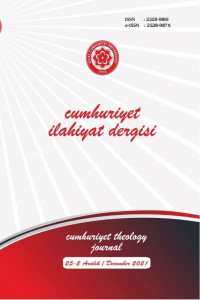Dindarlığın Psikolojik İyi Oluş Üzerine Etkisi: Meta-Analitik Bir Çalışma
The Effect of Religiosity on Psychological Well-Being: A Meta-Analytical Study
Author(s): Mehmet ÇınarSubject(s): Psychology, Theology and Religion, Psychology of Religion
Published by: Cumhuriyet Üniversitesi İlahyat Fakültesi
Keywords: Psychology of Religion; Religiosity; Mental Health; Psychological Well-Being; Meta-Analysis;
Summary/Abstract: The aim of this study is to analyse the effect of religiosity on psychological well-being via meta-analytical method. In addition, the presence of moderator variables that may cause the influence quantity which was calculated as a result of meta-analytical process, is analysed. For these aims, studies that are suitable for the criterion of choice were identified. Within this context, without applying a criterion for date, the influence quantity of 10 thesis studies were calculated, which analyse the correlation between religiosity and psychological well-being, and which include the number of samples used in meta-analysis and the number of pearson correlation coefficient (r) valu. Regarding the theses included in this study, 3 (30%) of them doctoral theses and 7(70%) of them are master’s theses. The number of people in samples is 5.914, 3.848 (65,06%) of which are from doctoral, and 2.066 (34,94%) of which are from master’s theses. For the analysis of the data, CMA (Comprehensive Meta-Analysis 2.0) statistical package program was used. The publication bias of the researches covered in this study was analysed via “Funnel Plot Graphic”, “Classic fail-safe N”, “Begg and Mazumdar rank correlations” and “Egger’s regression test” statistics methods. As a result of these statistical analyses, no evidence of publication bias has been found. Heterogeneity test was conducted to identify which model is to be used in measuring the influence quantity of the researches included in the study. The Q(sd=9) statistical value for its heterogeneity was measured as 114,90 (p<.01). If the obtained Q value read from the chi-square table (sd=9, χ2(0,05)16,919) exceeds 9 degree of freedom and .05confidence level values, it means that the data is heterogeneous. Another method used to determine heterogeneity is to measure I2 percentage value. The I2 value calculated through the obtained data is 92,167%. In the literature, the reference points for this value are respectively 25%, 50%, 75% as low, medium and high. In this sense, it is seen that the influence quantity distributions are highly-heterogeneous with a value of I2=92,167. According to the heterogeneity test results, there are two models, via which we can find the average influence quantity in meta-analysis namely, fixed effects model and random effects model. The fixed effects model depends on the assumption that all the compiled researches predict exactly the same influence. The fixed effect models assume that the variance between the results of researches stem from the data connected to one another of the researches. Random effects model, however, projects that it is better to make an analysis considering the variance inside and between the researches. It is assumed, in random effects model, that there are differences in terms of influence quantity between all researches. Since this study is heterogeneous, random effects model was used in meta-analysis process. According to the data included in meta-analysis, the influence quantity was calculated as positive .143. The lower limit for this influence quantity was calculated as .042, and the upper limit was calculated as .243. It was concluded that this influence quantity was in a low level. Scientific publication types and sample group were considered as moderator variables which can influence the relation between religiosity and psychological well-being. In this context, the average influence quantity of the studies covered in meta-analysis according to the mixed effects model for the subsample group in Fisher’s z is respectively .203 for families of martyrs, .148 for students, .233 for teachers, -.097 for the elderly, .098 for funeral service workers and .165 for mixed sample group. The average influence quantity for these subsample groups was not considered to be statistically significant (QB=1,577; p>0,05). According to this, it was concluded that the sample groups in the studies covered in the meta-analysis did not have a moderator role in the relationship between religiosity and psychological well-being. In addition, the average influence quantity for scientific publication types in Fisher’s z is respectively .193 for PhD, and .118 for master’s degree. The average influence quantity for these subsample groups was not considered to be statistically significant (QB=0,384; p>0,05), either. In other words, the type of publication does not play a moderator role in the relationship between religiosity and psychological well-being.
Journal: Cumhuriyet İlahiyat Dergisi
- Issue Year: 25/2021
- Issue No: 2
- Page Range: 583-596
- Page Count: 14
- Language: Turkish

